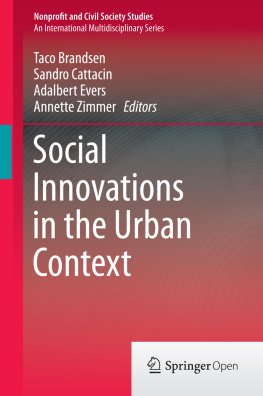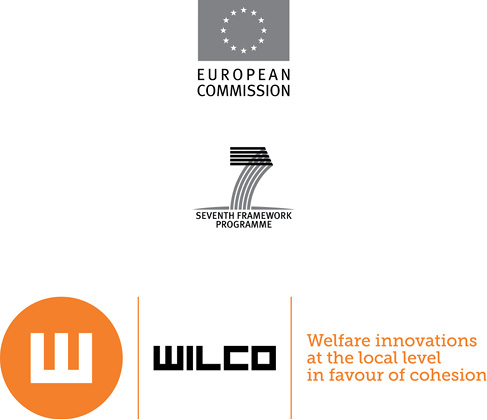Table of content
About this book
Social Innovations for social cohesion.
Transnational patterns and approaches from 20 European cities
Edited by Adalbert Evers, Benjamin Ewert and Taco Brandsen (eds.)
Liege: EMES European Research Network asbl
Design and layout: www.3lastic.com
Photos: Various authors
WILCO consortium
Reproduction is authorised provided the source is acknowledged.
This e-book is part of the research project entitled Welfare innovations at the local level in favour of cohesion (WILCO). WILCO examined, through cross-national comparative research, how local welfare systems affect social inequalities and how they favour social cohesion, with a special focus on the missing link between innovations at the local level and their successful transfer to and implementation in other settings. The WILCO consortium covered ten European countries and was funded by the European Commission (FP7, Socio-economic Sciences & Humanities). More information on WILCO can be found at: www.wilcoproject.eu.
ISBN: 978-2-930773-00-1
Acknowledgements
This e-book, presenting case studies on innovative ways of coping at local levels with challenges to social cohesion, has been made possible by contributions and collaboration from many sides.
We, the editors, first want to thank all the activists, professionals, administrators and policy makers that gave access to the innovative attempts, achievements and experiences, presented in this collection. In many interviews, personal conversations and information exchanges they gave time and shared their knowledge.
Likewise this e-book represents an important part of over three years of research and networking by the teams that contributed to the WILCO project.
Furthermore it should be kept in mind that there is quite a long way from research material to a presentation and publishing designed for a wide an easy access. The staff from the EMES International Research Network, coordinated by Roco Nogales, made this possible.
Finally it should not be forgotten, that the whole research and working project has been made feasible by funding from the 7 th Framework Programme of the European Union.
We, as the editors and organizers of this collection of cases of local social innovations are grateful for all of that. We hope that this book is interesting and helpful for a wide variety of people, reaching from activists on the ground and academics concerned over to politicians and professionals.
Giessen, Nijmegen, January 2014
Adalbert Evers
Benjamin Ewert
Taco Brandsen
Introduction
Social Innovations for social cohesion:
77 cases from 20 European cities
Recurrent patterns of approaches and instruments in local social innovations on methods and outcomes of a study in the framework of the WILCO project
Adalbert Evers and Benjamin Ewert
Keywords:
social innovation; service innovation; concepts and contexts; approaches and instruments; recurrent patterns of social innovations; ways of addressing users; internal organisation and modes of working; interaction with the local welfare system.
The project entitled Welfare innovation at the local level in favour of cohesion (WILCO), funded by the 7 th framework programme of the EU from 12/2010 to 1/2014, was given a double task:
> finding models, features and trends in local social innovation in support of social cohesion that appear across Europe despite national/local differences;
> looking at local contexts and welfare systems: what are key factors for diffusion and upgrading of such innovations?
In a nutshell, WILCO aimed to examine, through cross-national comparative research, how local welfare systems affect social inequalities and how they favour social cohesion, with a special focus on the missing link between innovations at the local level and their successful transfer to and implementation in other settings. Coordinated by Prof. Taco Brandsen from the Radboud University Nijmegen, WILCOs researchers (over 30 researchers from ten countries) chose 20 European cities for investigation. Each country studied was represented by one big and one medium-size city, namely: Zagreb and Varadin (Croatia), Nantes and Lille (France), Berlin and Mnster (Germany), Milan and Brescia (Italy), Warsaw and Plock (Poland), Barcelona and Pamplona (Spain), Stockholm and Malm (Sweden), Berne and Geneva (Switzerland), Amsterdam and Nijmegen (Netherlands) and Birmingham and Dover (United Kingdom).
This book, including the present introductory chapter, builds on Work Package V, one of the central work packages of the WILCO project. The main objective of this part of the research project was to describe instruments and approaches that are used by innovatory social projects and networks to fight social inequality and stimulate social cohesion. Therefore the tasks convened upon in WP V were:
> to identify a number of cases of innovation in each of the cities to be studied and to describe their characteristics in a way that was conducive to finding out recurrent patterns of approaches and instruments used;
> to identify such recurrent approaches and instruments used in the innovative cases.
Moreover the case studies had to point at the linkages between innovations and the local context that play a key role in the ways these innovations developed as projects and processes. This was intended to help getting a clearer image of the real impact these innovations already have in local welfare systems.
What are innovative approaches and instruments in local welfare systems? Are there post-conventional service patterns and path-breaking social offers emerging in times of austerity? Or does the latter prevent the former by definition? What differentiates a social innovation in, say, Milan from one in, say, Birmingham? Which local conditions and support do they require in order to unfold and blossom? What else do we know about ways and processes to adopt and adapt good ideas in practice? These questions constituted the origin of our search for social innovations in 20 European cities in ten countries. Seventy-five innovations were been analysed alongside a consented scheme. This constituted one of the first attempts towards such a systematic stock-taking; a similar effort had been made in another EU-funded research project, INNOSERV (2012), though. It appears that what INNOSERV researchers drew from their sample in terms of generalized findings on new logics, instruments and ways of proceeding in social services is quite similar to what was found in our sample, this introduction and the reading of innovatory cases it presents.
The present introduction to the presentation of the research we carried within work package V of the WILCO project starts in its first part with some general remarks concerning our research goals and the ways in which they were achieved. We first clarify the intellectual basis and the practical guidelines as they have been developed in order to find out and analyse innovations in the twenty cities studied. Four general aspects are addressed in this first part:
The understanding of social innovations;
Methods to sort out local examples of social innovation;
Ways of mapping the context of selected innovations;
Guidelines for ways of presenting and analysing the innovations.
In the second part of this introduction, a structured overview is presented on what we see as the main recurrent patterns of approaches and instruments as they show up in the descriptions of local innovations presented in the book. This major part of the introduction represents what one might call a possible way of reading and understanding the innovations from a social policy perspective. What are these innovations offering in terms of potential lessons to be learned by (local) social policies and those engaged in developing (local) social services that work better for social cohesion?







